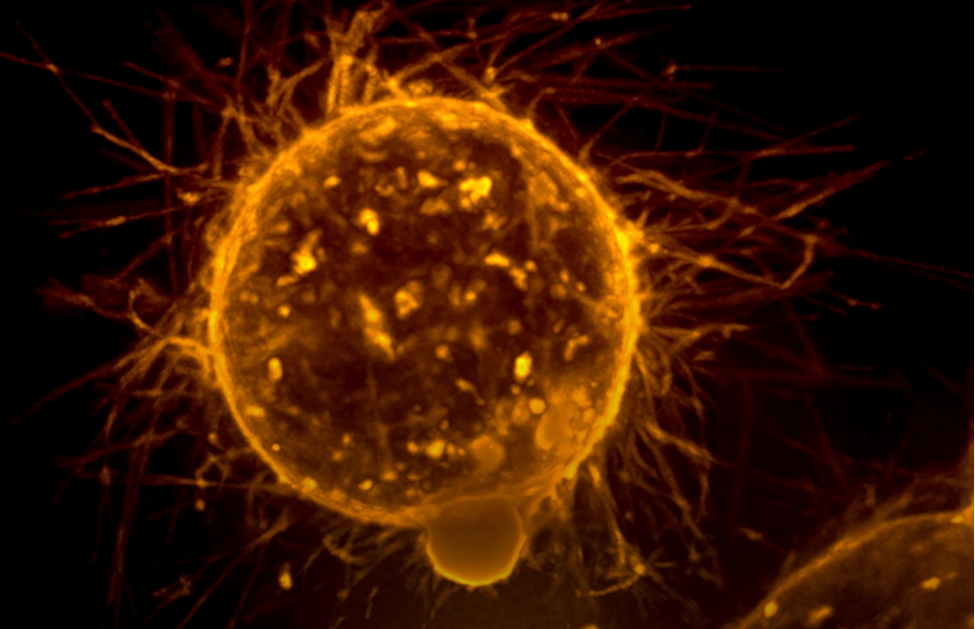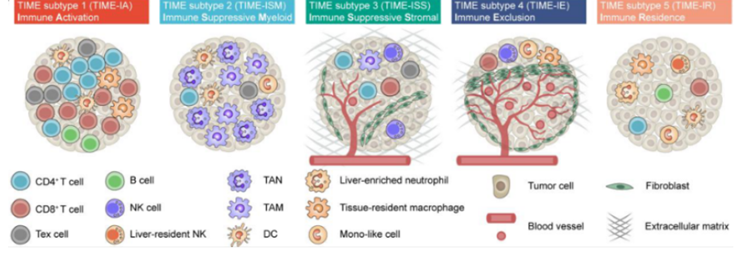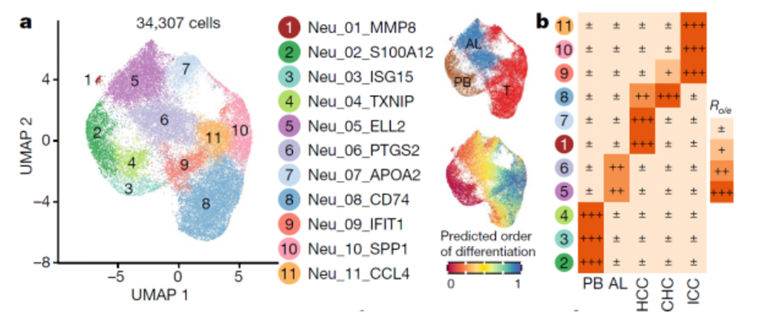Editor’s note: Liver cancer is also known as "the king of cancers." About 500,000 people die from liver cancer in China every year, which make up 55% of the world’s total liver cancer deaths. To treat cancer, we can directly target cancer cells with surgical resection, radiation therapy, chemotherapy, targeted therapy, etc., or we can fix the "microenvironment" in which cancer cells live i.e., through immune regulation, to stimulate the potential of the immune system to fight cancer. The 2018 Nobel Prize in Physiology or Medicine was awarded for this new approach to cancer immunotherapy, which demonstrates that research on the immune microenvironment is a new direction for cancer treatment.
Peking University, 22 November 2022: Zhang Ning’s team at the Translational Cancer Research Center, Peking University First Hospital, in close collaboration with Zhang Zemin’s team at the Beijing Advanced Innovation Center for Genomics (BIOPIC) of Peking University, and Zhu Jiye’s team at the Beijing Key Surgical Basic Research Laboratory of Liver Cirrhosis and Liver Cancer, Department of Hepatobiliary Surgery of Peking University People's Hospital, recently published a paper in
Nature entitled "
Liver tumor immune microenvironment subtypes and neutrophil heterogeneity." It is the first report of five subtypes of the immune microenvironment of liver cancer and entails new hope for cancer treatment.

The PKU team’s discoveries have brought renewed hope for liver cancer treatment and cancer therapy as a whole. The study defined the five immune microenvironment subtypes of liver cancer (TIMELASER), for the first time, in single-cell precision. It explored their cellular composition, spatial distribution, genomic characteristics and chemokine networks, and revealed the heterogeneity of tumor-associated neutrophils (TAN) for the first time. Also, their research discovered and validated the tumor-promoting mechanisms of two key subpopulations of CCL4+ and PD-L1+ TAN. Finally, by constructing a mouse liver cancer model, the research progressively demonstrated that targeting tumor-associated neutrophils is expected to form a new immunotherapeutic regimen for liver cancer at three levels: In vitro, Ex vivo, and In vivo. These results provided key information for basic research and clinical treatment of liver cancer.
What are the five subtypes of liver cancer’s "immune microenvironment”?
The immune microenvironment of each patient's cancer cells is different, and in order to achieve precise immunomodulatory therapy, it is necessary to clarify the immune microenvironment of cancer into several types. Therefore, the study of the immune microenvironment of tumors is a very important research direction. However, at the single cell level, no one has previously conducted sequencing studies, staining studies, etc. with this precision.
Based on the state of immune cells, the Peking University team summarized and proposed five types of immune microenvironments for the first time at the single-cell level of precision: immune activation type, immune suppressive myeloid type, immune suppressive stromal type, immune exclusion type, and immune residence type. Among them, the second and the third microenvironment are both immunosuppressive, but the immune cells that function are myeloid cells and stromal cells. This environment inhibits and prevents immune cells from working properly, making them unable to engulf and kill cancer cells, allowing them to do whatever they want in the body.
Therefore, for the immunosuppressive environment, we need to further investigate what makes our immune cells "go on strike." The team investigated the second myeloid-enriched immunosuppressive microenvironment and found that neutrophils, which have certain immune functions, were "defecting."
Demystifying the "defection" of neutrophils, one cell at a time
What are neutrophils? Neutrophils are the most abundant type of granulocytes in the body, accounting for 40% to 70% of all white blood cells in the body. It is logical that it should help immune cells together to engulf and kill invading cancer cells, as the previous view has been believed.
However, this experiment analyzed more than 30,000 neutrophils and found that some neutrophils not only did not attack well around the cancer cells, but also "turned" the immune cells to join the "strike" and watched the cancer cells grow. Finding this reason provides a new direction to improve the immune microenvironment, which is a new direction for liver cancer treatment in the future.
So, why were neutrophils not found to have "defected" in the immune microenvironment before? Firstly, it is because neutrophils are small in the microenvironment and can be easily overlooked if not observed with single cell precision. Secondly, it is also because neutrophils are a very fragile group of cells, which are usually thought to survive for less than a week in vivo and 24 hours in vitro after entering the peripheral blood (i.e., blood outside the bone marrow). Therefore, extraction and preservation are very difficult.
The successful analysis of neutrophils in this experiment was made possible, among other things, by the "non-antibody enrichment" strategy, which is a strategy for studying the cells in their entirety. For the team, this was a "bold decision" because all the cells had to be carefully analyzed in order to do a bias-free study. The team was given more than 1 million cells, in which the data processing is a great level of difficulty than the ordinary tens of thousands of cells, and the data analysis scheme was optimized and pushed back several times to achieve the optimal analysis results.
The biggest difficulty encountered in the study was cell sorting. When the team got more than 1 million pieces of data, they had to determine the class of each cell. The determination was based on the genes of the cells, and each cell has about 2000 genes on average. At the same time the cell subgroups have to be closely integrated with the published data, both by reading a large amount of literature to identify the already reported cell taxa, and by defining several completely new cell subgroups. Therefore, it was very rigorous and meticulous. After more than a year of preliminary data analysis, the team was able to define the categories of these more than 1 million cells.
Finally, the team obtained 89 small subpopulations covering 13 major categories, and 11 previously unreported neutrophil species were identified for the first time in the article. This sorting out of 89 subpopulations also provides a molecular genetic basis for future precision medicine in cancer treatment, not only for liver cancer but for all cancers.
"Cells can't wait, staying up late is the norm"
"We are able to be at the forefront of the world in this work, not only because of the advancement of experimental methods, but also because we have very good coordination between experiments and clinics." Professor Zhang Ning recalled the close cooperation of the team in scientific research, "Because our cells had to come according to the needs of patients doing surgery, we worked very closely with the clinic. At 8 or 9 o'clock at night, Mr. Xue and his team would wait outside the operating room, and as soon as the clinical group's samples came down, the experimental group immediately went to divide the cells, and it was common to divide them until 11 or 12 o'clock at night. Staying up late was the norm. Because the cells cannot wait, as long as three hours later, the cells will not be visible. To be able to do more than 100 people, more than 1 million cells, such a huge data sample, it is necessary to have the spirit of dedication. This is the advantage Peking University holds. All disciplines are accomplished and unified, and our teachers have dedication, which is what impresses me a lot."
Professor Zhang Ning’s group took the lead in proposing ideas and carrying out experimental design and operation, Professor Zhu’s group provided clinical samples, and Professor Zhang Zemin’s group provided bioinformatics analysis techniques. These three groups reflected the characteristics of modern scientific research: a large scientific problem requires the cooperation of multiple teams. Peking University is able to provide a platform for advantageous cooperation.
Another major innovation of this study is that the group combined data analysis and animal model validation very well. Zhang Ning described the article receiving a lot of attention from the academic community: "After we analyzed the data of the cases coming out of medical treatment, we also validated them through animal experiments, and the results of the data analysis and the matching of animal experiments reached a very good fit." This is an even stronger indication of the accuracy and scientific validity of the study.
Based on the conclusive data from the experiments, the team suggested that neutrophils could be an important target in liver cancer or even cancer treatment as a whole. This provides a very important and critical entry point for future liver cancer and general cancer treatment, and research and breakthroughs based on this will lead to better treatments and diagnostics regarding liver cancer in the future.
Written By: Jessica Xu
Edited By: Ng Joong Hwee
Source: PKU News (
Chinese)
Cover Photo: Unsplash.com




